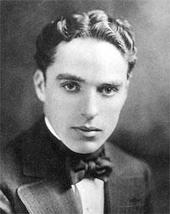Charlie Chaplin was one of the greatest and widely loved silent movie stars. From "Easy Street" (1917) to "Modern Times" (1936), he made many of the funniest and most popular films of his time. He was best known for his character, the naive and lovable -- Little Tramp. The Little Tramp, a well meaning man in a raggedy suit with cane, always found himself wobbling into awkward situations and miraculously wobbling away. More than any other figure, it is this kind-hearted character that we associate with the time before the talkies.
Born in London in 1889, Chaplin first visited America with a theater company in 1907. Appearing as "Billy" in the play "Sherlock Holmes", the young Chaplin toured the country twice. On his second tour, he met Mack Sennett and was signed to Keystone Studios to act in films. In 1914 Chaplin made his first one-reeler, "Making a Living". That same year he made thirty-four more short films, including "Caught in a Cabaret", "Caught in the Rain", "The Face on the Bar-Room Floor", and "His Trysting Place". These early silent shorts allowed very little time for anything but physical comedy, and Chaplin was a master at it.
Chaplin was known as one of the most demanding men in Hollywood. Regardless of the size the part, Chaplin walked each actor through every scene. Chaplin knew that a successful scene was not simply about the star, but about everyone on the screen. He demanded that the entire cast work together in every performance. Without this unity he could not express the subtlety of character that was so important to him. The only way to achieve that unity was to maintain complete control over every scene. This constant attention to detail ran many features over-time and over-budget, but the public reaction assured him and the studios that what he was doing worked. As his popularity increased he took more liberties with filming. Movies such as his 1925 hit, "The Gold Rush", demanded unending reworking of scenes and rebuilding of sets.
Though Chaplin is of the silent movie era, we see his achievements carried through in the films of today. With the advent of the feature-length talkies, the need for more subtle acting became apparent. To maintain the audience's attention throughout a six-reel film, an actor needed to move beyond constant slapstick. Chaplin had demanded this depth long before anyone else. His rigor and concern for the processes of acting and directing made his films great and led the way to a new, more sophisticated, cinema.
CHARLES CHAPLIN in "MODERN TIMES"
The Billows Feeding Machine
Add to My Profile | More Videos
